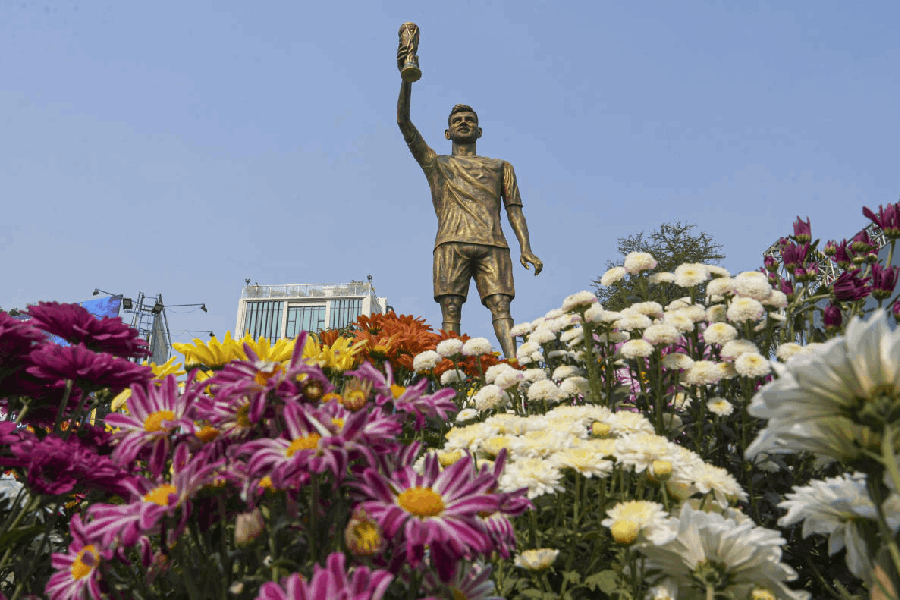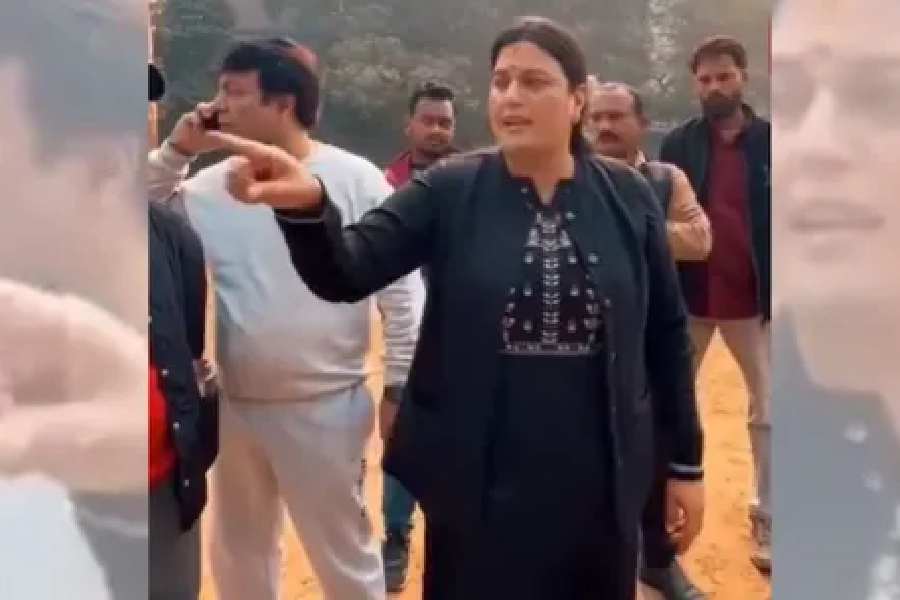 |
| PHOTOGRAPH COURTESY RAZA FOUNDATION |
Every afternoon, Syed Haider Raza manoeuvres his wheelchair into the studio of his new home in Delhi’s Safdarjang Development Area. Uttering a prayer, the country’s foremost living Modernist painter then clambers onto a chair on a raised platform and sets up his tools in front of his easel. Then, for the next three to four hours — and sometimes longer — the nearly 91-year-old artist shuts out the world and loses himself in his painting.
“I am going to be 91 soon so I have to be very careful about my health. I’m usually tired. But I paint regularly in spite of this and I’m very happy to be able to do that,” says the painter, who’s best known for his famous Bindu series of paintings.
Raza sits and paints nowadays after he fractured a thigh bone in a fall six months ago. His easel is set on a wooden frame so the canvas can be moved up or down to suit his restricted movements. Yet, neither age nor injury has dampened his passion for his art.
 |
| Raza’s masterpiece Saurashtra set a new auction price record when it sold for a huge Rs 16.4 crore at a Christie’s auction in 2010; PHOTOGRAPH COURTESY ART MUSINGS, MUMBAI |
Consider this. He has a big solo show opening at Delhi’s Vadehra Art Gallery on February 21 to coincide with his 91st birthday. The Delhi show will have works he has painted in recent months, and will travel to Singapore and Hong Kong afterward.
What’s more, this comes on the heels of another big solo show Raza held in Mumbai in December. The show, Vistaar, was his first one-man exhibition in Mumbai after returning to India from France in December 2010 — he had lived in France for over 60 years. Vistaar included 35 new works he painted over the preceding 12 months. And that isn’t all. Raza is already planning ahead for a show in New York in 2014.
“I just want to continue doing good work,” says the man who has played a prominent role in the history of Modern Indian art. Raza is the lone surviving member of the six original founders of the path-breaking Progressive Artists Group (PAG), which shaped the course of Modern art in India. Its other five co-founders were giants like F.N. Souza, M.F. Husain, K.H. Ara, S.K. Bakre and H.A. Gade. Artists like Ram Kumar and Akbar Padamsee joined later.
Raza is definitely one of the greatest stars of the Modernists. And the soaring prices in recent years have reflected how eager collectors are to get their hands on his works. Saurashtra, an abstract work from 1983, even broke the record for any Modern Indian painting when it sold — to art collector Kiran Nadar — for a stupendous Rs 16.4 crore at a Christie’s auction in 2010.
 |
| Raza’s recent show, Vistaar, held at Mumbai’s Jehangir Art Gallery (in picture) and Art Musings gallery drew a lot of attention as it was his first solo show in the city after his return to India from France; GAJANAN DUDHALKAR |
The latest Mumbai show, held by Art Musings gallery, was a homecoming of sorts for Raza. It opened at the Jehangir Art Gallery, just across the road from the erstwhile Bombay Arts Society Salon (now the Artist’s Centre) where as a young landscape painter, he’d held his first ever show over six decades ago.
“It’s my great happiness to have an exhibition of my recent works, which show the evolution of my style and ideas, in this city where I started my artistic career,” said Raza in Mumbai earlier.
At the heart of Raza’s paintings lies his deep knowledge of Indian philosophy. That’s combined with his interest in geometry and rich command of the colour palette. So, in his new works too, Raza keeps exploring favourite themes of the cosmos and cosmic energy as represented by the Mandala and the Bindu, as well as the Tree of Life, the panchtatva or five elements, Prakriti-Purusha and kundalini.
“Over the seven decades of his practice…Raza has been a pilgrim in the realms of philosophy and poetics,” says art critic and curator Ranjit Hoskote in an essay that accompanied the Vistaar show.
 |
| Raza paints seated on a specially-built platform in his Delhi studio after a fall restricted his movements |
“The most significant aspect of Raza’s work is how he is able to harness and find a way of articulating the energies of nature,” adds art historian Yashodhara Dalmia.
Hoskote says Raza’s art is distinguished by its “pulsating symbolism” and its “lavish and textural sensuality”. Vadehra Art Gallery’s Arun Vadehra says: “Raza’s one of the best colourists in the entire art world. He paints as if he’s conducting an orchestra and the way he uses colours in the context of Indology is almost sublime.”
Indeed, Raza’s repeated explorations into the Bindu have been likened to a jap or chant. “On the face of it, it seems like a Bindu. But the colour treatment and lines are all different so there’s an aesthetic of recurrence, not repetition, the utterance, rhythm and intonation bring about new meanings,” says poet and cultural critic Ashok Vajpeyi, a close friend.
Raza says: “I paint themes of interest to me but I do them in a new way each time.”
 |
| A young Raza (centre) is seen here with two other members of his Progressive Artists Group, F.N. Souza (far left) and Akbar Padamsee |
Ask about his move back from France and Raza responds he’s always been connected with India — he even kept his Indian passport. “I never left India in my heart or mind,” he says.
So, when his wife, French artist Janine Mongillat, died in 2002, he decided to return home. “My link with India was so strong I thought, ‘Why should I live in France where I speak French but my daily recitals are from the Bhagavad Gita and other religious books and from the sayings of the people of India?” he says.
Raza grew up in Barbaria, Madhya Pradesh, where his father was a forest ranger. The sylvan landscape of his childhood inspired him and he traces his interest in Indian spirituality to his early interactions with the villagers and his Hindu school teachers. “In the early years, the philosophy of the traditional people was important. Later, I started studying Indian philosophy,” he says.
He first studied art in Nagpur before joining Mumbai’s J.J. School of Art in 1943. There, his interactions with Mulk Raj Anand, the art critic Rudolf van Leyden and also Souza and Gade influenced him. It was also a time when young artists were torn between the colonial and Indian traditions of painting.
“You have to push yourself back and see the confusion in the mind of artists, which was very great. They did not know which path — new realism or abstraction — to follow in India in the mid-20th century. We were all struggling and we thought it best to go to Europe and decide for ourselves what the solution should be,” he recalls.
 |
| Raza started out by painting landscapes like Bombay (above), an oil on paper work done in 1959; PHOTOGRAPH COURTESY ART MUSINGS, MUMBAI |
 |
| Raza’s paintings are rich in symbols as in this work, Sansara, an acrylic on canvas painted in 1992 |
So, while Souza went to England, Raza chose France. He learnt French in Mumbai for two years before winning a scholarship to study at the prestigious Ecole de Beaux-Arts in Paris in 1950. It was there he honed his understanding of form and colour.
In India, Raza had painted realistic landscapes, travelling from Srinagar to Kanyakumari, to follow his muse. But in France his landscapes and townscapes acquired the tones of abstract expressionism. The early years were tough. But in 1956, he became the first foreigner to win the prestigious Prix de la Critique award, and he gradually began showing in Europe.
Through all this, he remained connected with India, corresponding and visiting whenever he could. Vajpeyi recalls when he first met Raza in Bhopal in 1979, he was struck by his perfect Hindi. “I was amazed that although he’d been away for 29 years, he spoke excellent Hindi. He hadn’t forgotten it,” says Vajpeyi. Later in Paris, he saw how effortlessly Raza switched between French, English and Hindi. “Any phone call that came from India, he’d talk in Hindi because he loved to hear his own language,” recounts Vajpeyi. Raza’s diary too is filled with jottings in all three languages.
By the mid-1970s, however, not content with being a part of the Parisian school, the artist “began asking questions about where is Raza and where is India in his work”, says Vajpeyi. It led to a searing transition as he turned to Indian philosophy and also Hindi poetry, lines from which often appear in his paintings.
“In France, I also painted landscapes but I evolved certain concepts of form and colour, which I developed and brought to Indology and ideas of Indian philosophy,” says Raza. As for the Bindu Raza says he was drawn to it both because of a childhood incident and because of its significance in Hindu cosmology.
“I was a poor student. So, my school teacher drew a bindu on the school wall and asked me to meditate on the point. He said ‘I want you to fix your mind on one thing’. That’s how the Bindu became very important. Later, I realised how important it is in Indian philosophy and I said why not integrate it into my work,” he recounts.
So, his painting underwent a shift in the 1980s as symbols like the line, circle, square and triangle began coming together. According to Vadehra, this transition phase of seven years to 10 years when Raza gradually moved from abstraction to geometric works is the most important phase of his career. And the early, pure geometric works of the 1990s “are absolutely great” too. That’s why paintings from this period are the most valuable. Saurashtra, for instance, was painted in 1983. In another series painted in the late 1990s, he did works in shades of white alone, suggesting, what Hoskote calls, a “transcendence”. Art Musings’ Sangeeta Chopra says: “There’s a spiritual connect when Razaji paints.”
Raza is “not a religious man but he’s deeply spiritual”, says Vajpeyi. In Delhi now, he goes to a church every Sunday, and a temple every Tuesday. “And on Friday, he quietly slips into a mosque. But he doesn’t carry out any rituals,” says Vajpeyi.
Vadehra admits that the artist’s recent works are selling for lower prices, ranging from Rs 5 lakh to Rs 50 lakh. Raza says he’s happy with the record prices his paintings have achieved but he’s not overly concerned with them.
“We didn’t think of money or fame when we began painting. We only thought of our passion as we set out in search of form and colour. Many young painters today compare their prices to Husain or Raza. But do the work first, money will come by itself,” he says.
It’s that passion that rules him even today.










